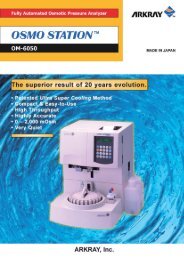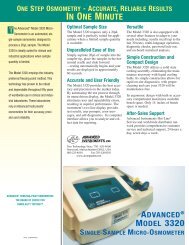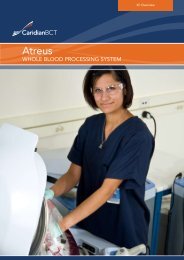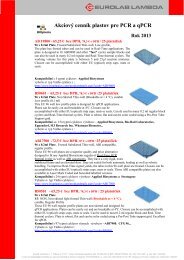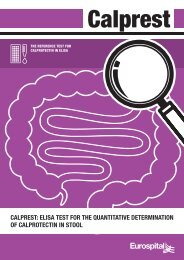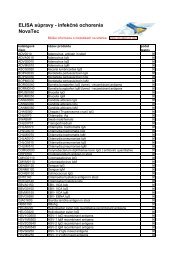Diagnostics Division of AGROLABO SpA group
Diagnostics Division of AGROLABO SpA group
Diagnostics Division of AGROLABO SpA group
You also want an ePaper? Increase the reach of your titles
YUMPU automatically turns print PDFs into web optimized ePapers that Google loves.
FELINE BLOOD GROUP DETERMINATION<br />
AGGLUTINATION TEST<br />
Identification <strong>of</strong> A, B, and AB blood <strong>group</strong>s<br />
The RapidVet-H feline card is the first commercially available in-house test for accurately<br />
classifying Type A, Type B or Type AB blood <strong>group</strong>s in cats. This practical and easy-to-use tests<br />
enables veterinarians to quickly determine a cat’s blood type in any consulting room, or even<br />
under field conditions, reducing the risks related to transfusions and hemolytic anemia.<br />
Available in several kit formats, 1, 5 or 20 tests, RapidVet-H feline kits provide qualitative, costeffective,<br />
ready to use diagnostics that can be trusted. All materials required for performing the<br />
test are including in the kits.<br />
RapidVet-H feline tests are based on an agglutination reaction that occurs when an erythrocyte containing<br />
either a type A, B, or AB antigen on its surface membrane, interacts with a lyophilised antiserum specific to the<br />
particular antigen.<br />
Type B cats have high specific antibody titre <strong>of</strong> type A blood. Rapid-Vet-H (Feline) kit uses these antibodies to<br />
recognize type A blood. The antibody molecule links and agglutinates the specific antigen <strong>of</strong> type A blood.<br />
Type A cats have low antibody titre <strong>of</strong> type B blood. The antiserum from type A cats cannot be used to develop<br />
a test sensitive to type B blood. Type B erythrocytes are characterized by Neu Ac2 G D3 form <strong>of</strong> neuraminic<br />
acid present in ganglioside and Neu Gc, present in type A erythrocytes, are not present. The specific link <strong>of</strong> this<br />
form with Lectin, Triticum Vulgaris is well known. The Rapid-Vet-H (Feline) kit uses lectin Triticum Vulgaris to show<br />
the presence <strong>of</strong> type B blood.<br />
In both cases, antiserum lyophilized on the card are reconstituted and mixed with whole blood from the patient.<br />
All type A erythrocytes react with their specific antiserum causing agglutination: all type B erythrocytes react in a<br />
similar way; all type AB erythrocytes reacts with both antiserum and agglutination will occur in any case. Results<br />
may be visually read.<br />
What are the risks <strong>of</strong> not blood typing cats?<br />
Transfusion Risks<br />
If cats are transfused, even once, with an incompatible blood type, a<br />
Hemolytic Transfusion Reaction ("HTR") will occur, resulting nearly<br />
always in death.<br />
Mating Risks<br />
Most <strong>of</strong> the kittens <strong>of</strong> an A(female)/B(male) mating will have A blood<br />
type. A high percentage <strong>of</strong> these kittens will <strong>of</strong>ten die suddenly after<br />
nursing in what is known as Fading Kitten Syndrome or Neonatal<br />
Isoerythrolysis ("NI"). In mating with a B type Queen, where the Tom is carefully chosen (B type), no risks are<br />
involved. However, where the Tom and Queen have incompatible blood types, their A type kittens will<br />
probably die unless they are removed from the mother immediately at birth and surrogate nursed.<br />
The conclusions are clear:<br />
• All cats should be routinely blood typed.<br />
• No cats should be mated before blood typing.<br />
• All kittens <strong>of</strong> incompatible matings should be blood typed at birth so that surrogate nursing can be<br />
started where necessary and the kittens allowed to thrive.<br />
22



